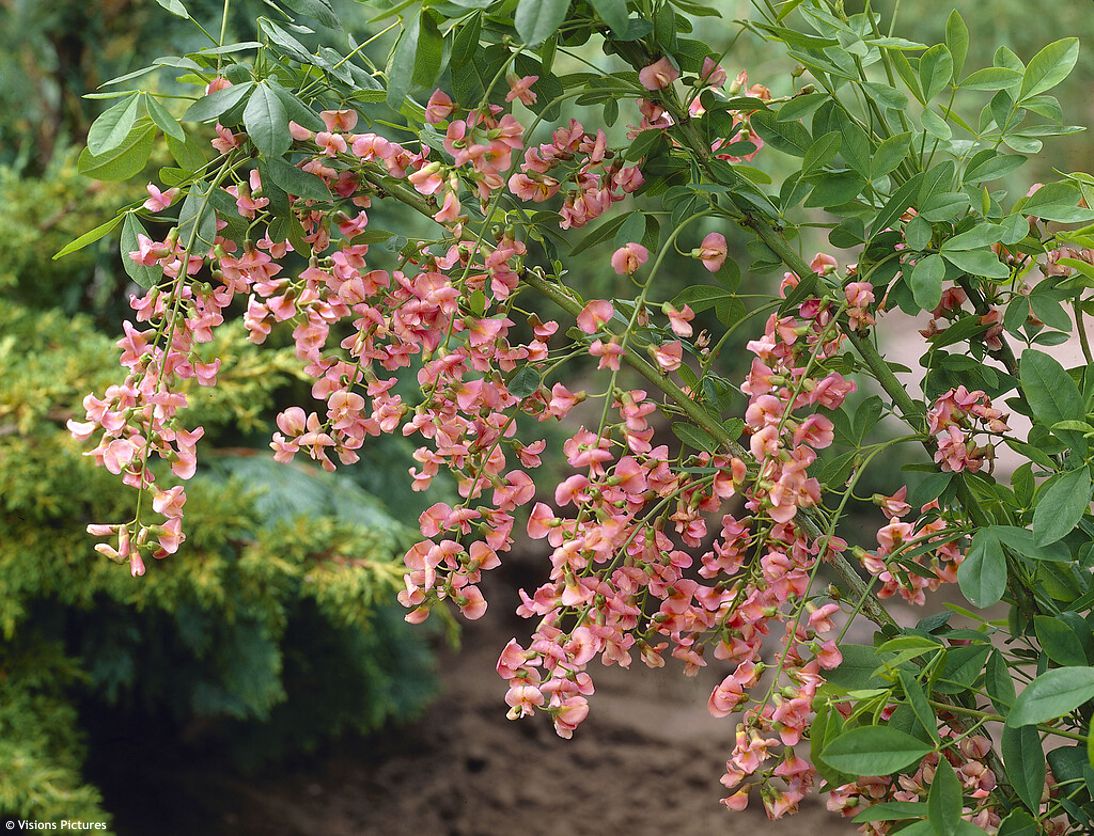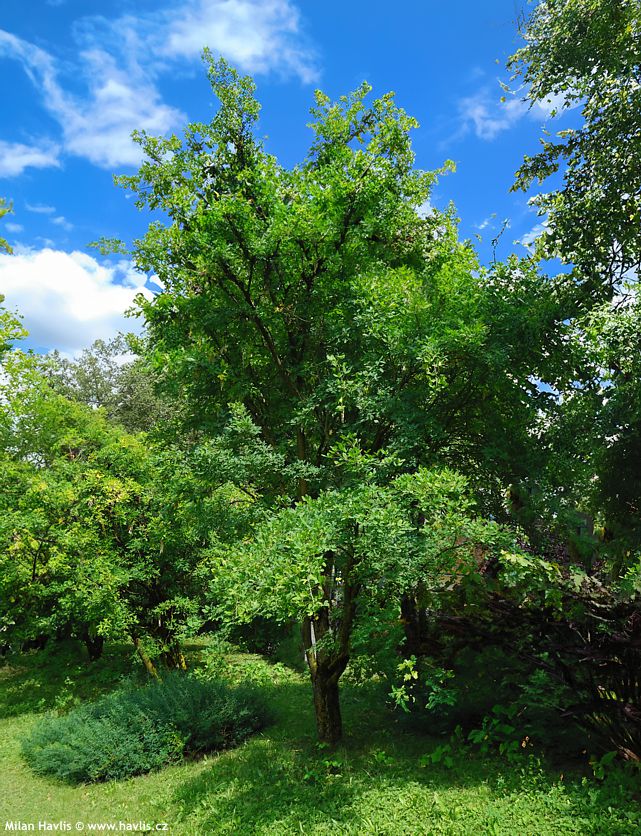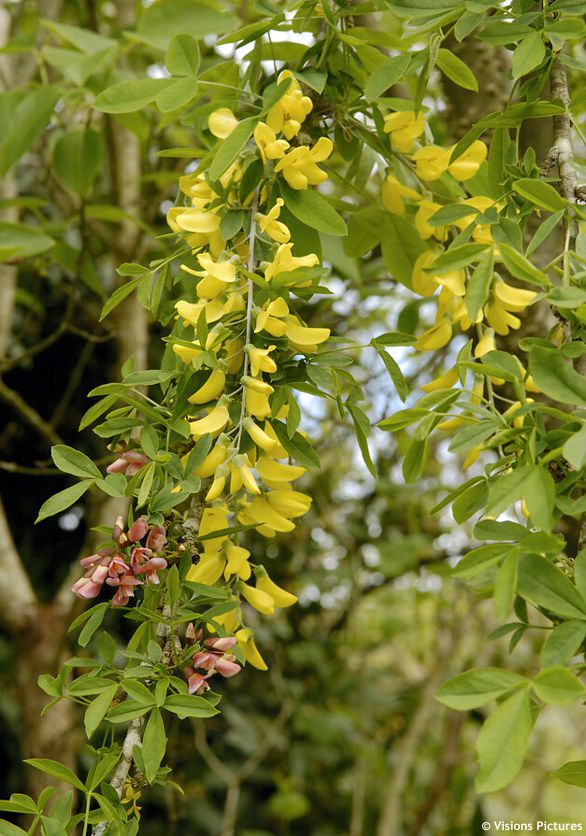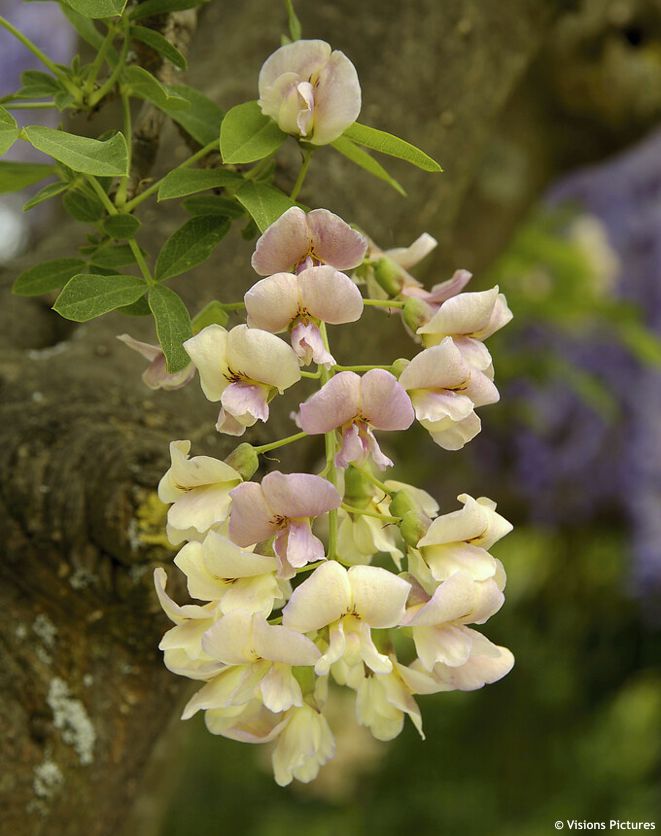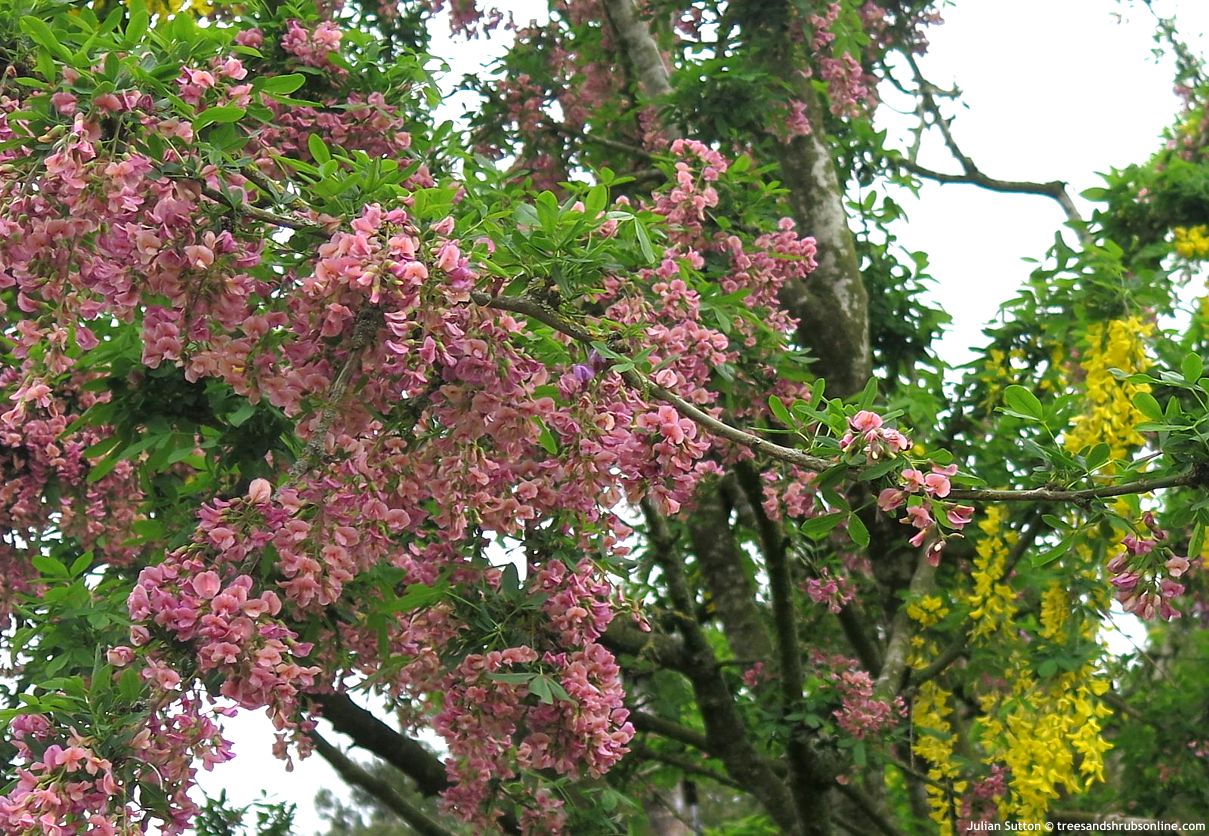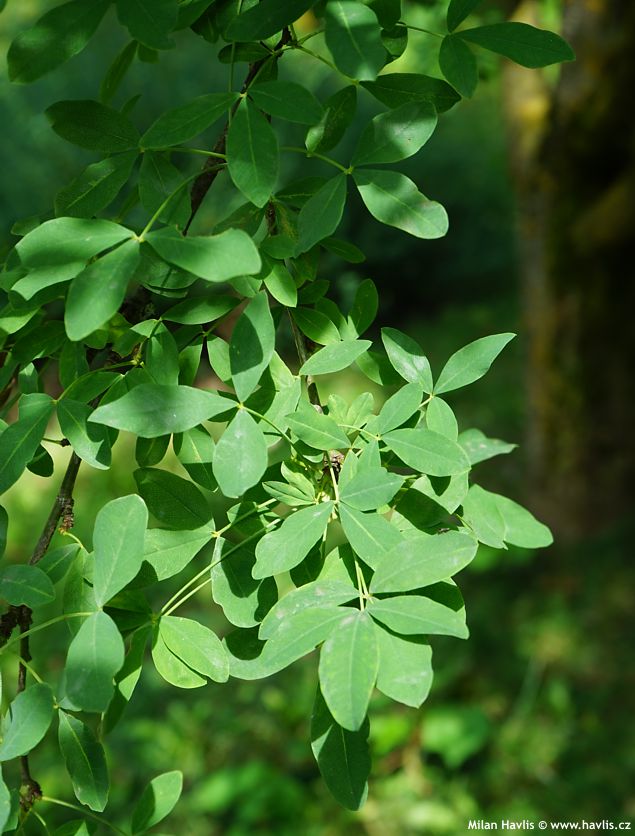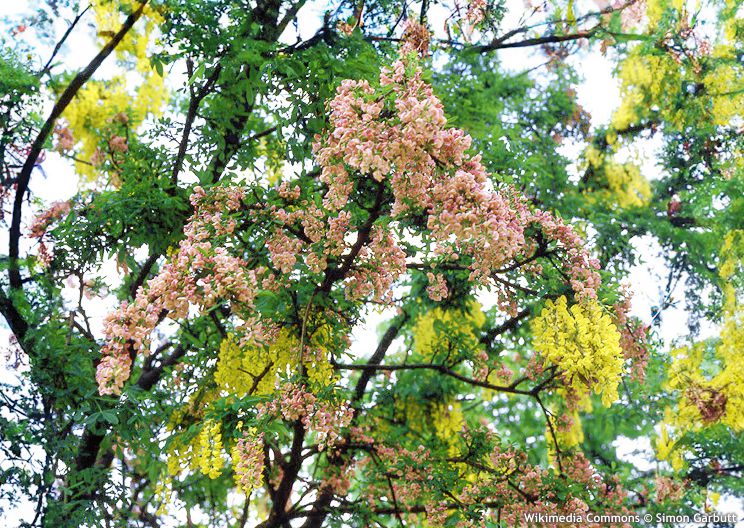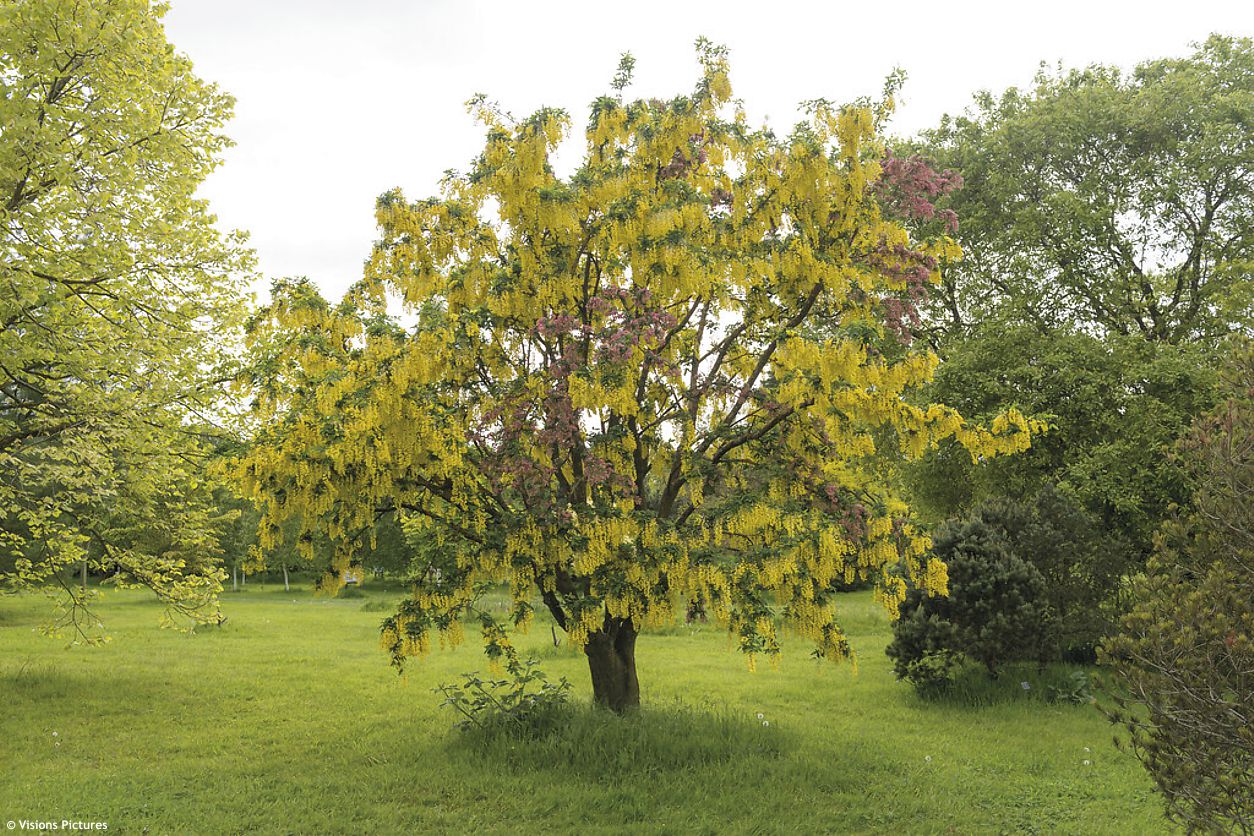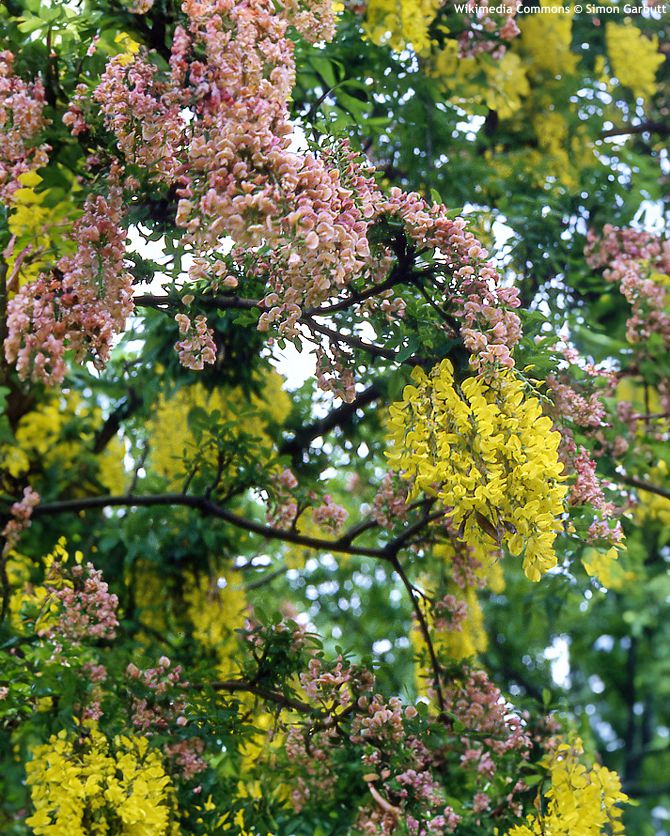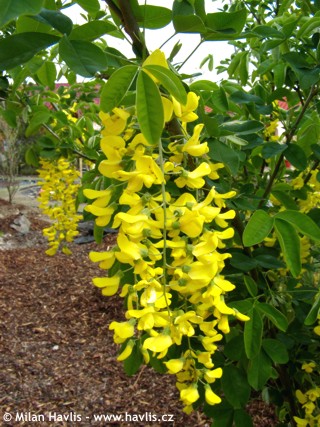+Laburnocytisus adamii Adam’s laburnum
Laburnocytisus
The genus +Laburnocytisus represents one of the most remarkable botanical curiosities, defying the usual classification of plants. It is not a natural genus formed by sexual hybridization, but a so-called graft-chimaera – a vegetatively created organism that unites two completely different plants from distinct genera: Laburnum and Chamaecytisus. Unlike hybrids marked with the letter ×, where genetic fusion occurs, a chimaera, marked with the symbol +, retains the genetic identity of both parents – in this case, Laburnum forms the inner tissues, while Chamaecytisus envelops the outer layers of the branches. The result is a fascinating mosaic of traits, most strikingly expressed in the inflorescences: on a single plant, clusters of flowers appear in three colours – yellow, purple and coppery pink – depending on which part of the branch has taken control of bud development and frankly – utterly irregularly!
Its origin is one of those botanical mysteries that reads almost like a legendary tale – but with the bold headline based on a true story. Around 1825, Jean-Louis Adam, a Parisian nurseryman from Vitry, noticed an unusual shoot on a plant he had just grafted. On the rootstock of common laburnum (Laburnum anagyroides) appeared a shoot with foliage and flowers that bore not only the traits of the grafted purple broom (Chamaecytisus purpureus), but something in between – a blend of both. At the point of union, a periclinal chimaera had formed, a vegetative fusion of two genera that kept their own genetic identity yet began to grow as one organism. Adam propagated the plant and introduced it as a horticultural curiosity, which quickly spread among botanical circles. It soon attracted the attention of prominent dendrologists and collectors – for example, William Bean, author of the famous British encyclopaedia Trees and Shrubs Hardy in the British Isles, described it as “a bizarre but fascinating result of grafting.” In England, it was planted at Great Corsham near the parish church, where it reached an impressive trunk girth of 59 cm before being felled by wind in 2014. Today, it grows in the Arnold Arboretum in Massachusetts, in the Botanical Garden of the University of Oslo, and in the Royal Botanic Gardens at Kew. It is still regarded as a scientific phenomenon – and quite possibly as much a historical artefact as an exhibit in a museum of curiosities.
At first glance, Adam's laburnum looks like an ordinary laburnum – an upright shrub or small tree with an open crown and smooth grey-green bark. But a closer look at the branches reveals that something is amiss. Some shoots bear the typical trifoliate leaves of laburnum, others have the smaller, oval leaflets of broom, and then there are those that seem like a compromise between the two – leaves with vaguely defined margins, slightly asymmetrical, as if the plant were unsure which genus it belongs to and crying out, “Help! I don’t know who I am!” 😊 This visual confusion, however, is only a prelude to what happens in the flowering season.
In bloom, usually from late May to June, this chimaera turns into a botanical palette. On a single plant, clusters of flowers appear in three colours: bright yellow (typical of laburnum), deep purple (characteristic of broom), and an unusual coppery pink found nowhere else – these flowers arise in the graft zone where the genetic layers of both parents overlap. The shape of the flowers also varies: some are classically papilionaceous, others smaller and more compact, as if the plant were trying to express both identities at once. Flowers often appear on different branches depending on which cell layer dominates – and sometimes even on the same branch in mixed combinations.
Growth is generally slower than in laburnum, with lower vigour and smaller annual increments. The habit tends to be irregular, often with asymmetric branching, which only emphasises its hybrid origin. Height usually does not exceed 3–4 metres, width is less but depends on conditions and training. As a vegetative chimaera, it cannot be propagated by seed – only by cuttings or renewed grafting, which limits its availability and makes it a collector’s rarity. In the garden, place it as a specimen in a prominent position where its unusual appearance and variable flowers can be admired. Thanks to its irregular habit, it suits naturalistic compositions where it will not look out of place but rather as an exotic curiosity, complemented by deciduous shrubs or small trees with contrasting foliage, such as black elder ‘Black Lace’ or willow ‘Golden Sunshine’.
This chimaera is not demanding on soil but thrives best in light, well-drained substrates with neutral to slightly alkaline reaction. It requires a sunny site – in shade it suffers from poor flowering and increased susceptibility to disease. Watering should be moderate; it dislikes permanently waterlogged soils. Fertilisation is unnecessary. Pruning is not required, but after flowering you may lightly trim for rejuvenation – because it is a chimaera, it is more sensitive to mechanical damage at the graft union, so heavy shaping cuts are not recommended. All parts of the plant are poisonous, especially the seeds. Its frost hardiness is comparable to laburnum, at least down to –30 °C (USDA zone 5), and it does not require any winter protection.
Last update 27-10-2025
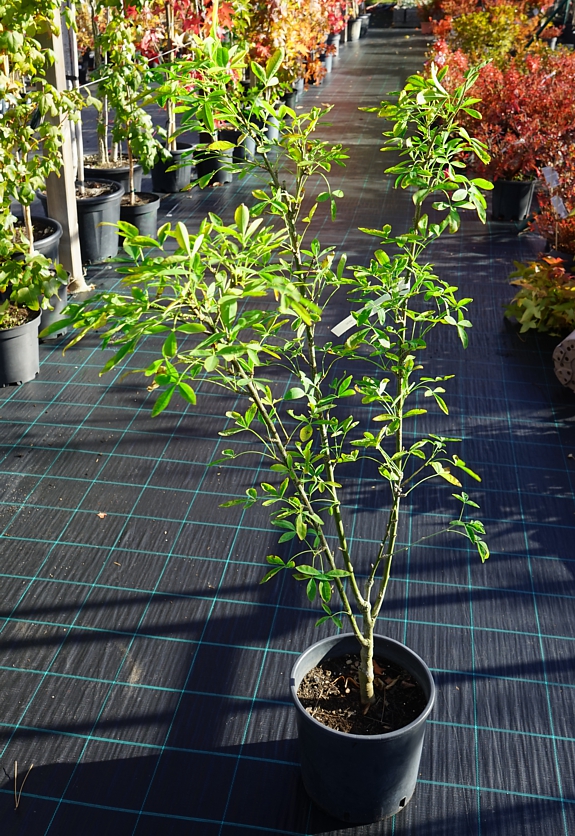
845,75 Kč

845,75 Kč
Goods are shipped all over Europe. For Russia and U.K. and for further details please read about SHIPPING OPTIONS HERE.
Are you interested in a serious discount for orders NOV-FEB? Check your options here.
THE PRICES INCLUDE VAT of 15%. For quick conversion you can use 1 CZK = approx. 0.04 EUR
- STANDARD QUALITY - Plants of this group are 1st class quality with number of branches and overall density adequate to their size and age, considering they were container grown.
- DE LUXE QUALITY - This label guarantees a luxurious quality of manually selected plants that, compared to their height and age, are exceptionally dense and beautiful.
- EXTRA - These plants are usually mature and bigger specimens with exceptional overall appearance.
- STANDARD (as described in the plant form) means a tree with a trunk of 190-210 cm and a crown at the top, unless specified differently. The commercial size for trees is their girth measured in the height of 1m from ground.
- HOBBY - These plants are of the same quality as our standard-quality plants but younger and therefore cheaper.
- SHRUB - a woody plant with branches growing bushy from the ground level.
- HALF-STANDARD or MINI-STANDARD - a small tree with shorter trunk, its size is usually specified.
- FEATHERED - These are trees with branches growing already from the base of the trunk and up along the stem.
- GRASSES and PERENNIALS - Sizes given usually read the diameter of the pot or the clump, as specified.

































.jpg)
